聊聊Laravel Excel 的五个鲜为人知的功能
- 青灯夜游转载
- 2023-01-11 20:43:182056浏览

Laravel Excel package 最近发布了 3.0 版本,它所具有的新功能,可以帮助简化高级需求,并且可用性极高。大家一起来探讨一下可能不知道的一些隐藏功能,这些功能使 Laravel Excel 成为 Excel 拓展的最佳首选。
1. 从 HTML 或者是 Blade 导入数据
假设已经有一个 HTML 表格
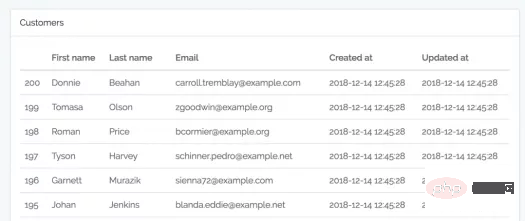
模版代码 -- resources/views/customers/table.blade.php:
<table class="table">
<thead>
<tr>
<th></th>
<th>First name</th>
<th>Last name</th>
<th>Email</th>
<th>Created at</th>
<th>Updated at</th>
</tr>
</thead>
<tbody>
@foreach ($customers as $customer)
<tr>
<td>{{ $customer->id }}</td>
<td>{{ $customer->first_name }}</td>
<td>{{ $customer->last_name }}</td>
<td>{{ $customer->email }}</td>
<td>{{ $customer->created_at }}</td>
<td>{{ $customer->updated_at }}</td>
</tr>
@endforeach
</tbody>
</table>你可以使用它去重复导入这个表格到 Excel
步骤1. 生成一个 Export 类
php artisan make:export CustomersFromView --model=Customer
步骤2. 使用 FromView 进行操作
namespace App\Exports;
use App\Customer;
use Illuminate\Contracts\View\View;
use Maatwebsite\Excel\Concerns\FromView;
class CustomersExportView implements FromView
{
public function view(): View
{
return view('customers.table', [
'customers' => Customer::orderBy('id', 'desc')->take(100)->get()
]);
}
}这里是导入的 Excel 文件:
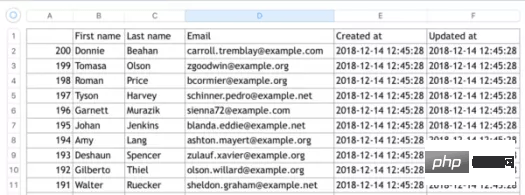
注意:这里只能导出 HTML 表格,不能具有任何标签,比如 html,body,div 等。
2. 导出到 PDF,HTML,或是其他格式的文件
虽然包的名称是 Laravel Excel,但是提供了多种导出格式,并且使用起来十分简单,只要在类里再添加一个参数即可:
return Excel::download(new CustomersExport(), 'customers.xlsx', 'Html');
比如这么做,就导出到了HTML,如下图所示:
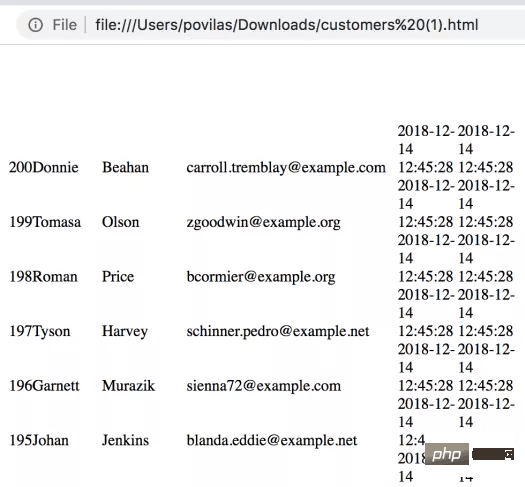
没有太多的样式,下面是源代码:

不仅如此,它还可以导出到 PDF,甚至你可以从中选择三种库,使用方法是一样的,你只要在最后一个参数指定格式就好了,下面是一些例子。 文档示例:
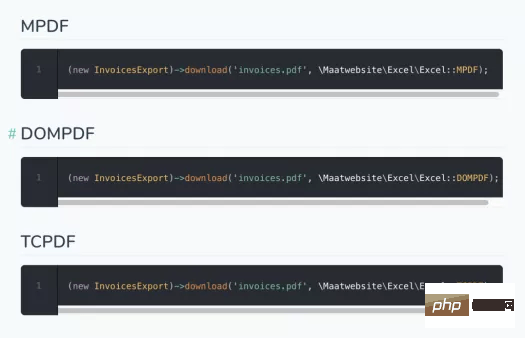
注意:你必须通过 composer 安装指定的 PDF 包,比如:
composer require dompdf/dompdf
导出的 PDF 如下所示:

3. 按需格式化单元格
Laravel Excel 有一个强有力的「爸爸」 -- PhpSpreadsheet。因此它就拥有其各种底层功能,包括各种方式的单元格格式化。
此处是一个如何在 Laravel Export 类中使用它的例子,例如 app/Exports/CustomersExportStyling.php:
步骤 1. 在头部引入适当的类。
use Maatwebsite\Excel\Concerns\WithEvents; use Maatwebsite\Excel\Events\AfterSheet;
步骤 2. 在 implements 部分使用 WithEvents 接口。
class CustomersExportStyling implements FromCollection, WithEvents
{
// ...步骤 3. 用 AfterSheet 事件来创建 registerEvents() 方法。
/**
* @return array
*/
public function registerEvents(): array
{
return [
AfterSheet::class => function(AfterSheet $event) {
// ... 此处你可以任意格式化
},
];
}这里有个例子:
/**
* @return array
*/
public function registerEvents(): array
{
return [
AfterSheet::class => function(AfterSheet $event) {
// 所有表头-设置字体为14
$cellRange = 'A1:W1';
$event->sheet->getDelegate()->getStyle($cellRange)->getFont()->setSize(14);
// 将样式数组应用于B2:G8范围单元格
$styleArray = [
'borders' => [
'outline' => [
'borderStyle' => \PhpOffice\PhpSpreadsheet\Style\Border::BORDER_THICK,
'color' => ['argb' => 'FFFF0000'],
]
]
];
$event->sheet->getDelegate()->getStyle('B2:G8')->applyFromArray($styleArray);
// 将第一行行高设置为20
$event->sheet->getDelegate()->getRowDimension(1)->setRowHeight(20);
// 设置 A1:D4 范围内文本自动换行
$event->sheet->getDelegate()->getStyle('A1:D4')
->getAlignment()->setWrapText(true);
},
];
}这些「随机」样例展示的结果如下所示:
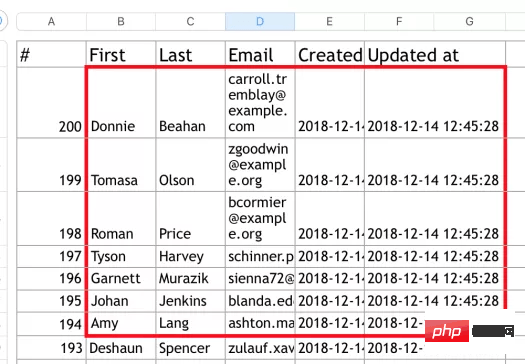
你可以在 Recipes page of PhpSpreadsheet docs中找到所有的以上以及更多示例。
4. 隐藏模型属性
假设我们已经创建了Laravel 5.7默认的users表:

现在我们尝试用简单的FromCollection来导出用户表数据:
class UsersExport implements FromCollection
{
public function collection()
{
return User::all();
}
}在导出的Excel 里,你只能看到如下字段,但是没有password和remember_token:

这是因为在User模型里定义了隐藏字段的属性:
class User extends Authenticatable
{
// ...
/**
* 这个数组用来定义需要隐藏的字段。
*
* @var array
*/
protected $hidden = [
'password', 'remember_token',
];
}所以,默认情况下这些字段是隐藏的,如果你想在导出数据的时候某些字段不被导出的话,可以直接在模型中定义隐藏属性$hidden。
5. 公式
出于某种原因,Laravel Excel 包的官方文档中并没有提及公式,但是这是Excel 重要的功能!
幸运的是,我们可以直接将公式写在导出数据的类中,我们需要设置cell 的值,就像这样:=A2+1 or SUM(A1:A10)。
其中一种方式就是实现WithMapping 接口:
use App\Customer;
use Maatwebsite\Excel\Concerns\FromCollection;
use Maatwebsite\Excel\Concerns\WithMapping;
class CustomersExportFormulas implements FromCollection, WithMapping
{
public function collection()
{
return Customer::all();
}
/**
* @var Customer $customer
* @return array
*/
public function map($customer): array
{
return [
$customer->id,
'=A2+1',
$customer->first_name,
$customer->last_name,
$customer->email,
];
}
}以上就是Laravel Excel的五个鲜为人知的功能。
原文地址:https://laravel-news.com/five-hidden-features-of-the-laravel-excel-package
译文地址:https://learnku.com/laravel/t/24161
【相关推荐:laravel视频教程】
以上是聊聊Laravel Excel 的五个鲜为人知的功能的详细内容。更多信息请关注PHP中文网其他相关文章!

